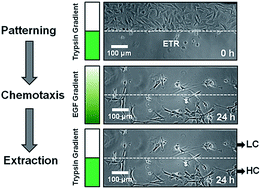Selection of chemotactic adipose-derived stem cells using a microfluidic gradient generator†
Abstract
Stem cells hold great promise for treating various degenerative diseases and conditions. However, the outcomes of preclinical and clinical cell therapy studies are still not close to our expectation. We believe that the unsatisfactory outcomes of cell therapy are at least partially due to insufficient homing of implanted stem cells into target organs and the use of heterogeneous cell populations for cell therapy. Therefore, there is a need to develop an effective guiding technique for stem cells to migrate to the target organs and to isolate effective stem cell populations. Toward this direction, we have previously demonstrated chemotaxis of rat adipose-derived stem cells (ASCs) to a well-defined gradient of epidermal growth factor (EGF) using a microfluidic device. In the current study, we further developed a microfluidics-based method for selecting chemotactic ASCs to EGF. This method integrates cell patterning, chemotaxis and cell extraction on a single microfluidic gradient-generating device. Post-extraction analysis confirmed the higher chemotactic migration of the extracted cells to EGF. Consistently, the extracted chemotactic ASCs shows up-regulated surface expression of the EGF receptor and its downstream signaling event upon EGF stimulation. The results suggest that our method provides a new effective approach for the selection of specific stem cell populations. It is also expected that the use of the selectively extracted stem cells could enhance stem cell homing to target organs and consequently improve the outcome of cell therapy.



 Please wait while we load your content...
Please wait while we load your content...